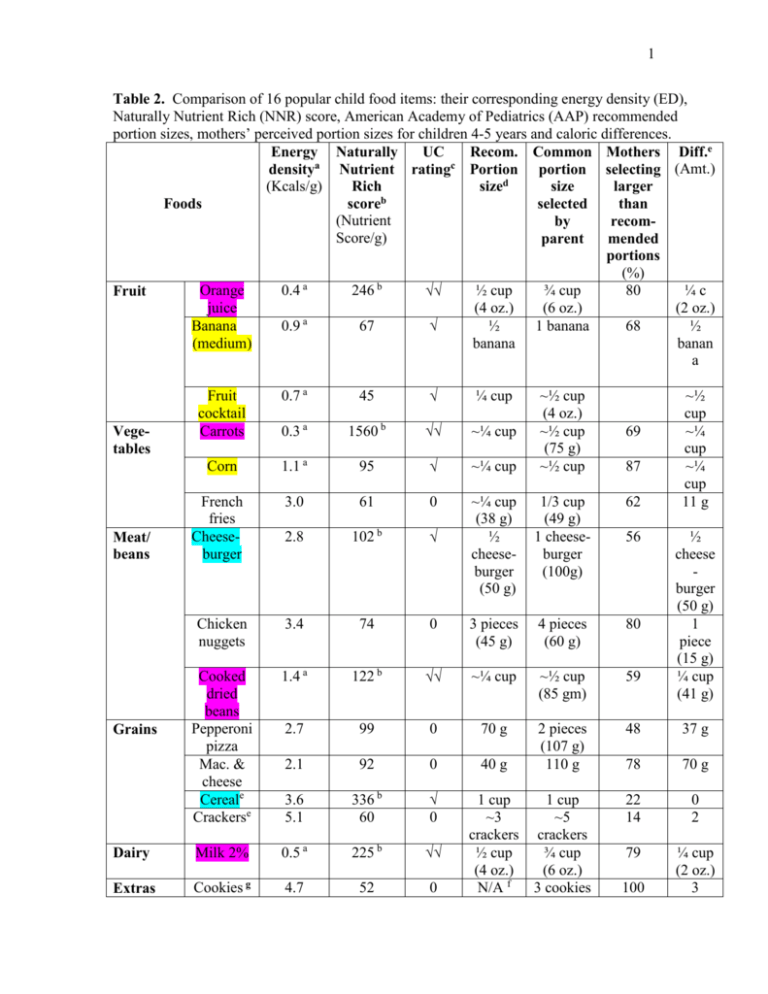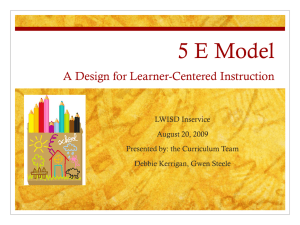Sidebar 1
advertisement

1 Table 2. Comparison of 16 popular child food items: their corresponding energy density (ED), Naturally Nutrient Rich (NNR) score, American Academy of Pediatrics (AAP) recommended portion sizes, mothers’ perceived portion sizes for children 4-5 years and caloric differences. Energy Naturally UC Recom. Common Mothers Diff.e a c density Nutrient rating Portion portion selecting (Amt.) (Kcals/g) Rich sized size larger b Foods score selected than (Nutrient by recomScore/g) parent mended portions (%) Orange 0.4 a 246 b ½ cup ¾ cup 80 ¼c Fruit √√ juice (4 oz.) (6 oz.) (2 oz.) Banana 0.9 a 67 ½ 1 banana 68 ½ √ (medium) banana banan a Fruit cocktail Carrots 0.7 a 45 √ ¼ cup 0.3 a 1560 b √√ ~¼ cup Corn 1.1 a 95 √ ~¼ cup French fries Cheeseburger 3.0 61 0 102 b √ 1/3 cup (49 g) 1 cheeseburger (100g) 62 2.8 ~¼ cup (38 g) ½ cheeseburger (50 g) Chicken nuggets 3.4 74 0 3 pieces (45 g) 4 pieces (60 g) 80 Cooked dried beans Pepperoni pizza Mac. & cheese Cereale Crackerse 1.4 a 122 b √√ ~¼ cup ~½ cup (85 gm) 59 2.7 99 0 70 g 48 37 g 2.1 92 0 40 g 2 pieces (107 g) 110 g 78 70 g 3.6 5.1 336 b 60 √ 0 22 14 0 2 Dairy Milk 2% 0.5 a 225 b √√ 79 Extras Cookies g 4.7 52 0 1 cup 1 cup ~3 ~5 crackers crackers ½ cup ¾ cup (4 oz.) (6 oz.) N/A f 3 cookies ¼ cup (2 oz.) 3 Vegetables Meat/ beans Grains ~½ cup (4 oz.) ~½ cup (75 g) ~½ cup 69 87 56 100 ~½ cup ~¼ cup ~¼ cup 11 g ½ cheese burger (50 g) 1 piece (15 g) ¼ cup (41 g) 2 (35 g) Tortilla chips g 5.5 61 0 N/A f 20 g (11 chips) 100 cookie s (35 g) 20 g a Energy density (ED) calculated as kcal/g. The food item meets this criteria: Energy Density score ≤ 2.0 kcal/g. b NNR (naturally nutrient rich) calculated using average of 14 nutrients, expressed as % daily value, normalized by amount of food needed to supply 2000 kcal per method of Drewnowski. The University of California (UC) single check (√) was given to a food with an Energy Density score ≤ 2.0 kcal/g or a NNR score ≥ 100/0. The University of California double check (√√) was given to a food meeting both criteria for diet quality: an Energy Density score ≤ 2.0 kcal/g and a NNR score ≥ 100/0. A ‘0’ indicates insufficient quality to meet criteria for University of California single check (√) c Recom.=Recommended. The American Academy of Pediatrics’ Feeding Guide for Children and the USDA Food Guide Pyramid for Young Children provided the guidelines for portion sizes for 4-5 year old children. d e Difference (Diff.) = recommended portion size minus common portion size selected by parents f Recommended for children is a lowfat, unsweetened cereal and a lowfat cracker such as a Saltine. g No serving size was designated by the American Academy of Pediatrics for this food. This item is considered an “eat less” food in the USDA Food Guide Pyramid for Young Children. Color code: High scorers (low energy dense + high nutrient dense): OJ, carrots, cooked beans, 2% milk Low energy dense: OJ, carrots, cooked beans, 2% milk + corn, fruit cocktail, banana High nutrient dense: OJ, carrots, cooked beans, 2% milk + cheese burger, cereal (with milk)









